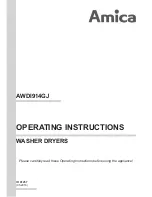
CAUTION
The washer must only be used with clean water; use of unfiltered water of corrosive
chemicals will damage the washer.
z
Push the motor switch to “OFF” position FIG. 9.
z
Check that the electrical supply voltage and frequency (Volt/Hz) correspond to those
specified on the washer rating plate. If the power supply if correct, you may now plug in the
washer.
8. OPERATION
z
Turn on the water supply tap fully.
z
Release the safety lock FIG.7 and FIG. 8, then press the trigger for a few seconds to
allow air to escape and to discharge residual pressure in the hose.
z
Keeping the trigger pressed, push the switch to start the motor FIG.9.
z
When re-starting the motor, always keep the trigger pressed.
NOTE:
THE MOTOR ONLY RUNS WHEN THE TRIGGER IS OPERATED.
USE DETERGENT
z
Fill the detergent tank to the level indicated through the inlet FIG. 10.
CORRECT USE OF STANDARD ACCESSORIES
z
The washer is equipped with the adjustable nozzle.
z
Jet adjustment from pencil to fan FIG. 11.
WARNING: DO NOT ADJUST THE NOZZLE WHILE THE TRIGGER IS SQUEEZED.
CORRECT USE OF TURBO NOZZLE
z
For increasing washing power, use the turbo nozzle kit as follows:
z
Turn off the high pressure washer.
z
Unscrew the adjustable head and fit the turbo nozzle onto the lance.
z
Turn the high pressure washer back on.
RECOMMENDED CLEANING PROCEDURE
z
Dissolve dirt by applying detergent with the fan jet to the dry surface. On vertical surfaces,
work from the bottom upwards. Leave the detergent to act for 1 to 2 minutes, but do not
allow to dry out. Apply the high from the surface, working from the bottom upwards.
z
Avoid allowing the rinsing water to run on to unwanted surfaces.
STORAGE (FIG.12 – FIG. 15)
z
Switch off the washer.
z
Turn off the water supply tap.
z
After use, the detergent residuals should be removed from the tank.
z
Discharge residual pressure by pressing the trigger until no more water comes out of the
lance nozzle.
z
Engage the gun safety lock.
z
Remove the plug from the socket.
z
Operate the washer with non-corrosive/ non-toxic antifreeze before storing for the winter.
WARNING:BEFORE REUSING, COMPLETELY FLUSH THE UNIT OUT WITH PLAIN
WATER. ANTI-FREEZE CAN DAMAGE PAINTWORK SO YOU MUST ENSURE THERE IS
NO ANTI-FREEZE LEFT IN THE SYSTEM BEFORE USING IT AGAIN.
9. MAINTENANCE
CAUTION
Before working on the washer, disconnect the plug from the power supply socket.
z
To ensure good performance, check and clean the suction and detergent filters after every
50 hours of operation FIG. 12.
z
Clean the nozzle with the tool provided. Remove the lance from the gun, FIG. 13, remove
any dirt from the nozzle hole (FIG. 14) and rinse.
10. Circuit Diagram
11. DISPOSAL
Recycling the washer
Do not dispose of electrical appliances as unsorted municipal waste, use separate
collection facilities.
Contact you local government for information regarding the collection systems available.
If electrical appliances are disposed of in landfills or dumps, hazardous substances can
leak into the groundwater and get into the food chain, damaging your health and
well-being.
When replacing old appliances with new ones, the retailer is legally obligated to take back
your old appliance for disposals at least free of charge.
























